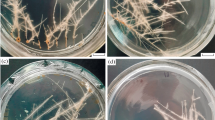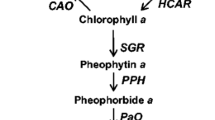Abstract
In 5′; non-coding regions of genes for phytochrome A from horseradish (ArPHYAs) were fused with the 35S promoter of cauliflower mosaic virus in the antisense direction (CaMV35SantiArPHYAs) and introduced into horseradish hairy roots. Phytochrome levels of proximal areas in many hairy roots that had been transformed with CaMV35SantiArPHYAs decreased to levels of about one-half to one-quarter those of control hairy roots. The extent of the light-induced formation of adventitious shoots from hairy roots with less than half of the control level of phytochrome was lower than in the controls and not different between the three ArPHYAs. In contrast, the efficiency of phytochrome on the extent of shoot formation differed in hairy roots transformed with CaMV35SantiArPHYAs when phytochrome levels were more than 0.02 (Δ;(Δ;A) g−1). The efficiency of ArPHYA3 to initiate shoot formation was greatest and that of ArPHYA2 was smallest. Furthermore, previous reports on hairy roots overexpressing ArPHYAs showed a similar efficiency of phytochrome on shoot formation. These results indicate that the ArphyA1 and/or ArphyA3 play major roles in the light-induced formation of adventitious shoots and that ArphyA2 has a minor role.
Similar content being viewed by others
References
Casal JJ (2000) Phytochromes, cryptochromes, phototropin: photo-receptor interactions in plants. Photochem. Photobiol. 71: 1–11
Clack T, Mathews S &; Sharrock RA (1994) The phytochrome apoprotein family in Arabidopsis is encoded by five genes: the exsequences and expression of PHYD and PHYE. Plant Mol. Biol. 25: 413–427
Chory J (1997) Light modulation of vegetative development. Plant Cell 9: 1225–1234
Franklin KA, Praekelt U, Stoddart WM, Billingham OE, Halliday KJ &; Whitelam GC (2003) Phytochromes B, D and E act redundantly to control multiple physiological responses in Arabidopsis. Plant Physiol. 131: 1340–1346
Hauser BA, Cordonnier-Pratt M-M, Daniel-Vedele F &; Pratt LH (1995) The phytochrome gene family in tomato includes an novel subfamily. Plant Mol. Biol. 29: 1143–1155
Huala E, Oeller PW, Liscum E, Han I-S, Larsen E &; Briggs WR (1997) Arabidopsis NPH1: a protein kinase with a putative redox-sensing domain. Science 278: 2121–2123
Kagawa T, Sakai T, Suetsugu N, Oikawa K, Ishiguro S, Kato T, Tabata S, Okada K &; Wada M (2001) Arabidopsis NPL1: a phototropin homologue controlling the chloroplast high-light avoidance response. Science 291: 2138–2141
Kamada H, Ono A, Saitou T &; Harada H (1992) No requirement of vernalization for flower formation in Ri-transformed Cichorium plants. Plant Tiss. Cult. Lett. 9: 206–213
Kamada H, Tachikawa Y, Saitou T &; Harada H (1995) Effect of light and growth regulators on adventitious bud formation in horseradish (Armoracia rusticana). Plant Cell Rep. 14: 611–615
Lin C, Yang H, Guo H, Mockler T, Chen J &; Cashmore AR (1998) Enhancement of blue-light sensitivity of Arabidopsis seedlings by a blue light receptor cryptochrome 2. Proc. Natl. Acad. Sci. USA 95: 2686–2690
Murashige T &; Skoog F (1962) A revised medium for rapid growth and bioassay with tobacco tissue cultures. Physiol. Plant 15: 473–497
Quail PH, Boylan MT, Parks BM, Short TW, Xu Y &; Wagner D (1995) Phytochromes: photosensory perception and signal transphogenesis duction. Science 268: 675–680
Saitou T, Kamada H &; Harada H (1992) Involvement of phyto-chromes on light-induced adventitious shoot formation of horse-radish hairy roots. Plant Physiol. 99: 1336–1341
Saitou T, Tachikawa Y, Kamada H, Watanabe M &; Harada H (1993) Action spectrum for light-induced formation of adventiti-ous shoots in hairy roots of horseradish. Planta 189: 590–592
Saitou T, Tokutomi S, Harada H &; Kamada H (1999) Overexpression of phytochrome A enhanced the light-induced formation of adventitious shoots on horseradish hairy roots. Plant Cell Rep. 18: 754–758
Saitou T, Tokutomi S, Harada H &; Kamada H (1999) Quantitative correlation between concentration of photoreactive phytochrome and light induction of adventitious shoot formation in horserad-ish hairy roots. J. Exp. Bot. 50: 1837–1844
Saitou T, Hashidume A &; Kamada H (2000) Genes for phytochrome A in horseradish: isolation of cDNAs and analysis of expression during light-induced formation of adventitious shoots from hairy roots. Plant Cell Rep. 19: 1212–1218
Sakai T, Wada T, Ishiguro S &; Okada K (2000) RPT2: A signal transducer of the phototropic response in Arabidopsis. Plant Cell 12: 225–236
Sharrock RA &; Quail PH (1989) Novel phytochrome sequences in Arabidopsis thaliana: structure, evolution, and differential exsequences pression of a plant regulatory photoreceptor family. Genes Dev. 3: 1745–1757
Author information
Authors and Affiliations
Corresponding author
Rights and permissions
About this article
Cite this article
Saitou, T., Hashidume, A., Tokutomi, S. et al. Reduction of phytochrome level and light-induced formation of adventitious shoots by introduction of antisense genes for phytochrome A in horseradish hairy roots. Plant Cell, Tissue and Organ Culture 76, 45–51 (2004). https://doi.org/10.1023/A:1025898131364
Issue Date:
DOI: https://doi.org/10.1023/A:1025898131364




